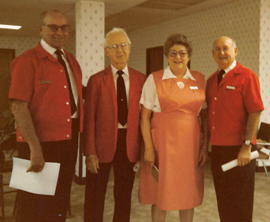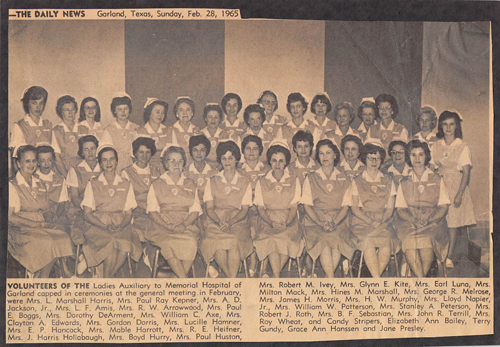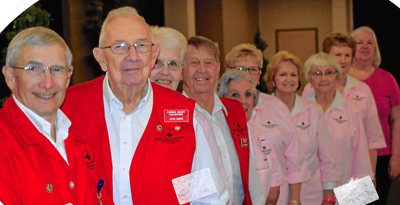Anyone looking for some good, clean, cheap entertainment should grab a big tub of popcorn and have a seat in the Garland Healthcare Auxiliary office where there is a bookcase containing more than 50 years of articles and pictures. These items chronicle the story of the auxiliary which will make past, present and current members proud.
In 1959, Melvin “Mike” Mitchell, treasurer of the newly formed Garland Memorial Hospital Board, picked Mrs. H. R. Busby to enlist the help of Garland women in the project. Approximately 50 women met in late October of that year to form the Women’s Auxiliary. While presiding at this meeting, Mrs. Busby spoke words that are still true, “A wish to belong to the auxiliary boils down to a basic desire to help others.” On that day, they established the group’s purpose: To render service to the Memorial Hospital and its patients. From that day forward that’s what the auxiliary has done.
The first action item was to establish a constant source of income. Charter members made “a fine array of hand-worked baby clothes, dolls, ceramics and other items” to sell in the Gift Nook, a name that reflected its original size. The gift shop has remained the one constant over the life of the auxiliary, though its size and location has changed the items offered have reflected the trends of each decade. Gift shop sales have financed the bulk of donations the auxiliary has made to the hospital. Donations began with a $10,000 pledge in 1960 and were up to more than $2 million before the hospital merged and became for-profit.
Those donations have made landscaping improvements, furnished rooms, purchased equipment, outfitted a new emergency room wing, helped fund a new ICU, a cardiac care unit, cardiac cath lab, operating room and much more.
To raise additional funds, members stocked vending machines, hooked up TV service to patients, took baby pictures or sold popcorn. Each three-hour shift has kept the auxiliary going.
Since 1966, the auxiliary has awarded college scholarships to high school seniors interested in the medical field. The first scholarship recipients were junior auxiliary volunteers. In 1972, boys joined the summer program and the first men joined the auxiliary, necessitating a name change.
Over the next four decades the auxiliary continued awarding scholarships made possible by dances, sales, a bicentennial fair, bazaars and percentage-sales-fundraisers that are currently being used. For 50 years, auxiliary members have given their time and talents to organize, decorate, bake, craft, advertise and work during these events.
Financial donations are only half of the story. The organization has also served patients since the hospital opened March 16, 1966. Volunteers continue to welcome visitors, escort patients, answer questions, deliver flowers and more. The volunteers are a great source of comfort and always make time for patients and their families.
As the hospital changed, the auxiliary changed and added services. For newborn babies, they provided Health Record Checkbooks, baby pictures and t-shirts. They also provided curtains for nursery feeding rooms and sponsored a car seat safety program called “Buckle Up Baby”
The group hosted public programs about cancer and first aid, held a blood pressure screening clinic and sponsored blood drives and health fairs. They provided toys for the ER; started a Lifeline program for seniors living alone; established a Caring Hearts program for patients and families experiencing heart surgery and much more.
Before the acquisition of Garland Memorial Hospital by Baylor in 1991, a newspaper article stated about the auxiliary, “It is interesting to note that the Auxiliary may be one of the chief assets.”
If Mrs. Busby were here, she would agree with the newspaper’s assessment. She would find that the auxiliary stayed true to its purpose. For over five decades, as the hospital has grown and changed names, added services and square footage, the auxiliary has been there, growing and changing right along with it.”
When the hospital became for-profit in 2015, the name was changed again. Although the auxiliary’s donations can no longer go directly to the hospital, helpful ways to spend funds in ways that serve its patients continue to be identified.




